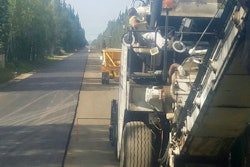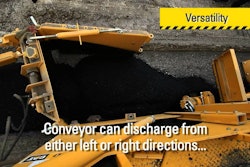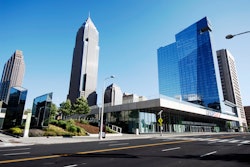Most pavement sealers are commonly supplied as concentrates (undiluted), which must be mixed with water, silica sand/aggregate, and additives for proper application consistency and desired performance properties, according to the manufacturer’s recommended mix designs. The words mix designs denote the engineered composition where the ingredients in the sealcoating system are combined, prior to application in the number of coats per specifications.
The purpose of this article is to discuss the intricacies in mix designs, the function of the components and why the components must be mixed in proper proportions. [It is imperative that the sealcoating professional read and understand the product literature, Safety Data Sheet (SDS) and Detailed Application Specifications, before starting the job.]
Let us review the relevance and qualifications of various ingredients in the sealcoating mix design.
Dry Film Thickness vs. Wet Film Thickness
Most pavement sealers are an intimate dispersion of a binder (refined tar, asphalt or a special resin), clays, fillers, emulsifiers, and specialty chemicals, in water. A sealer selected for a project must meet all applicable specifications and standards (such as ASTM, FAA, Commercial etc.). The sealer shall be uniform in consistency, smooth, and free of debris and foreign objects. If the sealer is ready to use (if it’s not concentrate), make sure that you know the percentage of water already added to it. This is important to know so you can deduct that amount of water from the additional water that you may have to add for a specific mix design.
The sealer’s performance is dictated by the thickness of the cured film deposited on the pavement. At this point it is important to understand the calculation of wet (WFT) and dry film thickness (DFT) of sealcoating film at the recommended application rates.
Generally the application rates are specified as “gallons per square yard” of the concentrated sealer as well as the final mixture (according to the mix designs). The rate expressed for concentrated sealer is done strictly for the calculation of the sealer quantity required for a project. For application, the application rate is denoted for the mixture is to be used.
To calculate the film thickness, we have to first determine the coverage rate in terms of sq. ft./gallon. To do that we need to know that 1,604 square feet of pavement are covered by one gallon of coating in one (1) mil thickness. If the film thickness is 4 mils, the area covered will be 1,604 ÷ 4, or roughly 400 sq. ft./gallon. Conversely, if you divide 1,604 by the square foot coverage rate you will get the film thickness in mils (1,604 ÷ 400 = 4 mils).
But if the coverage rate is specified in gal./sq. yd., you need to convert it into sq. ft./gal. To convert, divide 1 by the number of gallons per square yard, then multiply the answer by 9 (the number of feet in a square yard) to reach the number of square feet per gallon.
So, the wet film thickness is calculated from the application rate of the mixture by dividing it into one (1) and multiplying by 9 to convert the result into “square feet per gallon.” The resulting number divided into 1,604 yields the wet film thickness (WFT).
To determine the dry film thickness (DFT), multiply the WFT with the “solids by volume content of the mix design,” which for this example is 38.6% (or .386 for calculation purposes).
Example: To determine the wet film thickness at 0.25 gal./sq. yd. application rate, divide 0.25 into 1 and multiply with 9 to get coverage in sq. feet per gallon:
(1÷ 0.25) x 9= 36
Then divide 1,604 by 36 to get the WFT:
1604 ÷ 36 = 44.55 mils thick when the sealer film is wet.
To calculate the DFT, multiply 44.55 by the solids by volume content of the mix 38.6% (@ an average recommended dilution of 25%) = 17.2 mils.
DFT = 44.55 x .386 = 17.19 (round up to 17.2) mils thick
Adding Water to the Mix
In sealcoating mix designs, the water is the largest component. Water imparts the proper flow and leveling characteristics, thus allowing the coating to spread evenly and coat the pavement uniformly. The water used in the mix shall be;
· Clean, potable (drinkable), and low in hardness and iron. Hard water and water with high iron content may produce uneven cure and also streaky appearance.
· Free of suspended solids and metal contaminants, which may interfere with the proper cure and uniform appearance.
· Between 7-8 pH. Low pH water may thicken the mix. Conversely high pH may have a thinning effect.
Note: Well water must be tested for its suitability. Test data on water can be obtained from the city water treatment department.
What if:
· Not enough water is added to the mix? The mix will be too heavy (i.e. viscous and high in solids). It will not spread uniformly and may deposit a heavy, uneven film. It may result in:
o Costly mix, wasted material.
o Potential tracking under hot ambient conditions.
o Uneven appearance, ridges and brush and squeegee marks. With spray application the sealer may have fine dimpled “orange peel” type of appearance.
· Excessive water is added to the mix? The mix will result in:
o A thin cured sealer film that will wear out prematurely, resulting in inferior performance.
o Sealer not covering the aggregates properly and have a tendency to flow into the valleys of the profile.
Again, the sealcoating’s performance is profoundly affected by the solids content of the mixture. For every 5% additional water, the solids content declines by about 4% -- and so does the Dry Film Thickness. Also, it is important to know that the sealer performance declines rapidly with excessive dilution.
Adding Sand, Aggregate or Boiler Slag
Sand, aggregate or boiler slag is commonly added to the sealer at a rate of 2-4 lbs. of sand per gallon of concentrated sealer. The cutoff point is about 5-6 lbs. Adding sand/aggregate/slag to sealer provides the following benefits:
· Improved pavement appearance: Uniform textured surface, reduced sun glare, streak-free appearance.
· Hides minor surface defects and fills hairline cracks.
· Improves traction. Be cautious in making claims about the skid resistance of the sealer; it is generally not recommend for inclined surfaces.
· Improved wear ability of the sealer.
What if:
· No or very little sand/aggregate/slag is added?
o The above-mentioned benefits are not realized
· An excessive amount is added?
o Adding more than 5-6 lbs. per gallon of sealer concentrate may result in the sealer film becoming too tough and brittle to flex with the pavement. In addition, such films generally may run into bonding issues and peel off from the pavement surface.
o This limit of 5-6 lb. is placed because the sealer film progressively becomes tougher and less flexible with increasing amounts of sand/aggregate, at the cost of the adhesive properties of the sealer film. The tensile and adhesive strengths are competing properties, which need to be kept in balance. Sand, though an inert filler, does absorb some binder from the sealcoating. When too much sand/aggregate is used it absorbs enough binder that can weaken the film – as the binder it absorbs should otherwise be available for bonding to the pavement and keeping the fillers and other components tightly bound in the film.
Note: Do not use recycled sand from steel sand blasting, or foundry.
Additional comments:
Sand must be:
- Quartz, angular, clean and washed.
- Free of contaminants, metals, clay and trash.
- Of fineness 50-75 mesh AFS (American Foundry Standard).
- It is recommended that you purchase bagged sand/aggregate/slag. This insures that the sand is dry and it is measured in units that can be used in developing your mix design.
- Boiler slag (often marketed under the name Black Beauty) can be used in sealer mix designs but many sealer producers often prefer using clean quartz, angular, silica sand. Silica sand has surface absorptivity, therefore it becomes an integral part of the coating. Boiler slag, on the other hand, has a very hard surface that does not absorb the binder and therefore doesn't become a part of the coating as well as sand. Also, producers of sand have a more precise control of the particle size compared to boiler slag. It's often observed that the larger particles of boiler slag are knocked off from the cured coating, causing premature wear of the sealcoating.
- Silica sand is generally less expensive than boiler slag.
- Safety Aspects. The use of sand in sealcoatings improves surface traction. Sealer without sand may become slippery under wet surface conditions and cause cars and people to slip and slide. Property owners and contractors have encountered lawsuits where injuries are claimed from falling on sealcoated surfaces.
- Do not sealcoat steeply inclined surfaces. Never claim that sealcoatings with sand will stop slipperiness. Seek sealcoating manufacturer’s advice on such matters.
How and Why to Use Additives
Today, there are a myriad of additives available to sealcoaters. As a matter of fact, most work done in the last 25-30 years in the sealcoating industry can be attributed to additives. It is imperative to understand the types of the additives and their benefits. The additives are primarily based on:
Rubber/Polymers Latices: Acrylonitrile/Butadiene (AB) additives have been used since the late 1960s as a part of the Federal Aviation Administration (FAA) specifications. They have been the workhorses of the sealcoating industry. It has been established that the additives based on Acrylonitrile/Butadiene:
- Meet FAA specifications.
- Improve toughness, flexibility and durability of the sealer
- Increase sand/aggregate/slag suspension and skid resistance
- Improve gasoline, oil and chemical resistance
- Improve color uniformity
- Improve drying time, especially under unfavorable weather conditions
Over the years additives based on 100% acrylics, poly/vinyl acrylic, nitrile, styrene butadiene etc. have been developed and used in sealcoatings.
Non-Polymer Additives: Based on chemicals and surfactants, non-polymer additives are more recent introductions. They contain specialty chemicals, surfactants and pH-adjusting chemicals. These additives have a limited performance record and the only aspect of their property that can be seen in sealcoatings is their thickening effect, which is a very common property of most of the additives, anyhow.
Additional additive comments
It is imperative to follow manufacturer’s instructions for selecting additives for a specific purpose, and their blending procedure, into the batch.
- Pre-mix the additive with an equal volume of water, prior to adding it into the mixing tank. This reduces the “shocking” effect. For pre-dilution it is a good practice to add water into the latex additive, not vice-versa, in order to avoid latex destabilization in the additive.
- Do not use additives with premium-grade sealers, which already have built-in rubbers and specialty chemicals.
- Do not mix various additives together, even from the same manufacture. Seek their permission if you intend to use several additives in the same mix.
- Highly crucial: Do not use additives from a supplier different than your sealer supplier. This may cause destabilization of the mix, meaning a severe gelling (thickening, destabilization) problem due to reactions between the additives.
- General purpose additives can be used in most refined tar-based sealer (RTS), because of the similarity in composition of various brands of RTS, which, in turn, is guided by the applicable specification, e.g. ASTM 5727-00.
- Important: You cannot take the same liberty with asphalt-based sealers due to the fact that there are various types of asphalt emulsion (AE) based sealers available on the market, which are made in different ways using various types of chemicals, fillers and specialty chemicals. There are two main types of AE products, one commonly is made using pre-emulsified asphalt, called soap emulsions: tack coat SS-1-H (negatively charged particles, anionic), and CSS-1-H, (positively charged particles, cationic). It is strongly recommended that you let your additive supplier know that your sealer is made with SS-1-H, CSS-1-H or is clay stabilized. A negatively (anionic) charged additive may destabilize a sealer that made with positively (cationic) chemicals.
Summary
Pavement sealers are commonly supplied as concentrates, which have to be mixed with water, sand/aggregate/slag and additives in recommended proportions, prior to application. It is strongly recommended to follow manufacturers’ recommendations for mix design and application rates. Water, sand and additives have to meet all the purity, gradation and chemical requirements to achieve the desired performance properties. Make absolutely sure to avoid excessive amounts of water and sand as they may have deleterious effects on the overall performance of the sealer.
Girish C. Dubey is president of STAR Inc., Columbus, OH, which produces sealcoating products and also licenses sealer manufacturing technology; www.starseal.com.


![Lee Boy Facility 2025 17 Use[16]](https://img.forconstructionpros.com/mindful/acbm/workspaces/default/uploads/2025/09/leeboy-facility-2025-17-use16.AbONDzEzbV.jpg?auto=format%2Ccompress&fit=crop&h=100&q=70&w=100)







![Lee Boy Facility 2025 17 Use[16]](https://img.forconstructionpros.com/mindful/acbm/workspaces/default/uploads/2025/09/leeboy-facility-2025-17-use16.AbONDzEzbV.jpg?ar=16%3A9&auto=format%2Ccompress&fit=crop&h=135&q=70&w=240)








